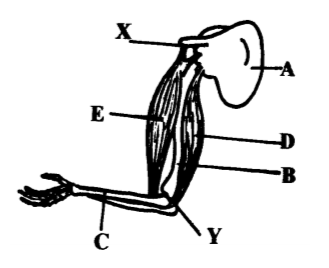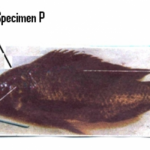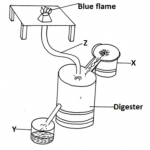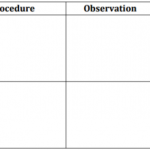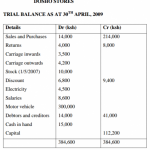KCSE Biology Paper 2 – 2014 EKSIKA Joint Evaluation Test
2014 EKSIKA Joint Evaluation Test
Biology Paper 2
SECTION A (40 Marks)
Answer all questions in this section.
The diagram below shows a set up to investigate a factor necessary for germination.
(a) Name the factor under investigation. (1mk)
(b) State the role of pyrogallic acid in the set up. (1mk)
(c) Which type of respiration is taking place in the beans? (1mk)
(d) Write a word equation for the process named in (c) above. (1mk)
(e) Explain why plants can only carry out the above respiration process for a short while. (1mk)
(f) State other three factors necessary for germination. (3mks)
8 marks
The diagram below shows the arrangement of bones and muscles in a human arm.
(a) Name the parts labeled A , B and C. (3mks)
(b) Explain how parts D and E bring about flexing and extending of the arm.(2mks)
(c) Name the types of joints found at points X and Y. (2mks)
(d) Name a fluid found in all the movable joints. (1mk)
8 marks
(a) i) Name the blood vessel that connects arteries to veins. (1mk)
(ii) Explain three ways in which the vessels named in (a) (i) above are adapted to carry their functions. (3mks)
(b) Name the blood vessel with the highest concentration of:
(i) Glucose (1mk)
(ii) Carbon (IV) Oxide. (1mk)
(c) (i) Sate the function of cardiac muscles. (1mk)
(ii) What is a single circulation? (1mk)
8 marks
In a family of four children, the father had blood group A while the mother had blood group B.One of the children had blood group O.The father wanted to commit suicide accusing his wife of infidelity?
(a) Was this accusation justified? (1mk)
(b) With the use of a punnet square work out the genotype of other children.(4mks)
(c) The child of blood group O can donate blood , to all other children but can receive blood from none. Explain. (2mks)
(d) One of the other children was able to receive blood from all the other children but donate to none. What was the blood group of such a child? (1mk)
8 marks
(a) Distinguish between Osmosis and Active transport. (2mks)
(b) Study the figure below and answer the questions that follow.
(i) Which solution has higher concentration of free water molecules.(1mk)
(ii) Which solution is more concentrated? (1mk)
(iii) In which direction will Osmosis take place? (1mk)
(iv) What does semi-permeable membrane represents in an animal cell. (1mk)
(c) Name two processes in living organisms that depend on Osmosis. (1mk)
8 marks
SECTION B (40 Marks)
Answer question 6 and either question 7 or 8.
A group of students estimated the population of the grasshoppers in the school
compound. The table below shows the number of grasshoppers collected from the
eight sites within the compound.
| .Site | 1 | 2 | 3 | 4 | 5 | 6 | 7 | 8 |
| No. of grasshoppers | 250 | 50 | 190 | 220 | 85 | 300 | 175 | 30 |
(a) Draw histograms to represent the number of grasshoppers collected from each site. (6mks)
(b) The students caught 240 grasshoppers marked them and then released them. After five days they caught 160 grasshoppers and found that 40 were marked. Work out the grasshoppers population. (3mks)
(c) Identify the method used in (b) above. (1mk)
(d) Name the instrument the students used to collect and mark the grasshoppers. (2mks)
(e) The students encountered a number of limitations. State any three of the limitations. (3mks)
(f) The students observed the organisms and placed them into their correct phylum and class.
(i) Name; Phylum…………………………………………………………..
Class……………………………………………………………. (2mks)
(ii) What features were observed for the grasshoppers to be placed in their correct;
Phylum………………………………………………………………….
Class……………………………………………………………………. (3mks)
20 marks
Describe how the human skin is adapted to its function.
20 marks
(a) State three aspects of light that are important in photosynthesis. (3mks)
(b) Describe how the leaves of plants are adapted to carry out photosynthesis.(17mks)
20 marks

